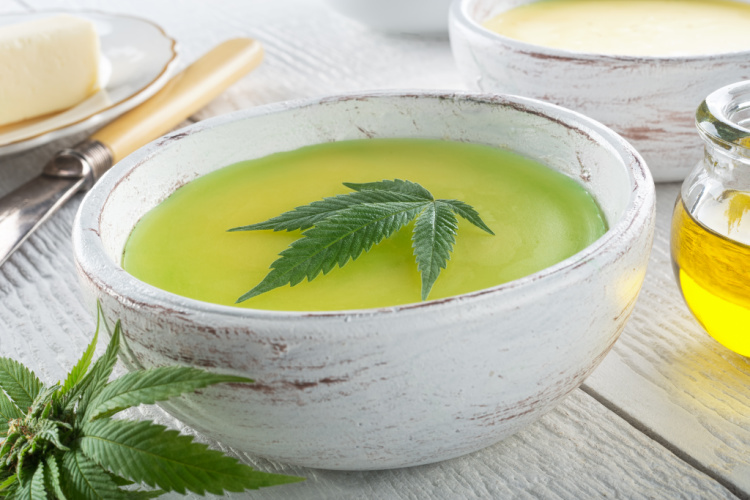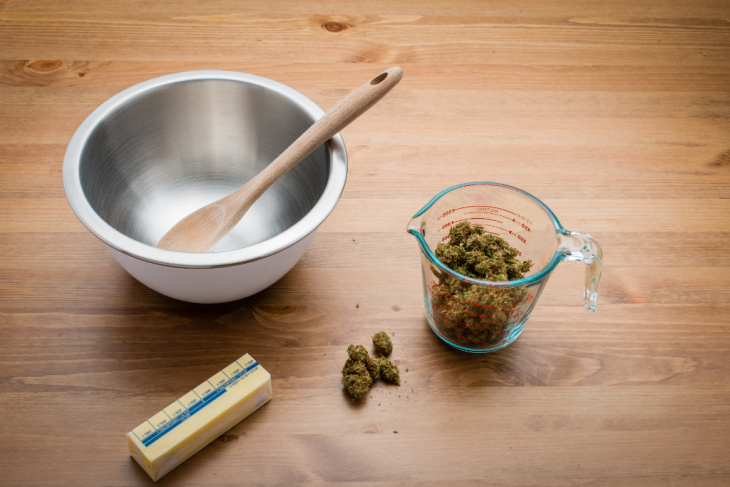If you’re at all curious about the world of cannabis edibles, you’ve probably heard about cannabutter, the simple cannabis-infused butter or vegan oil. A favorite among cannabis chefs and medical patients, cannabutter is easy to make and versatile, providing a basic building block for a variety of cannabis edibles. You can quickly add cannabis butter to any number of recipes or dishes to make them truly special. And as you’re probably aware, cannabis edibles are highly effective and long-lasting.
If you’re looking to make your own cannabis edibles at home, you’ll want a potent, shelf-stable batch of cannabutter to start with. And there’s some good news: regardless of your experience level, there’s no need to be afraid to dive in. Whether you make your cannabutter with RSO or some other source of cannabinoids, you don’t have to be a chef or cannabis expert to make top-notch butter!
Keep reading to learn more about how to quickly and easily make your own batch of cannabis-infused butter at home.
Should I Use Cannabis Flower, THC Distillate, or Rick Simpson Oil?
First things first: Why do you need to make cannabutter (or cannaoil)? Can you use any liquid to make your cannabis infusion? It turns out you can’t. The “active ingredients” in cannabis—the cannabinoids such as THC and CBD—bind to fat, not water. Even when you consume a store-bought cannabis-infused beverage that doesn’t contain any fat, the cannabinoids have first been extracted into some useable form, such as a tincture or other liquid.
Before beginning the infusion process, you’ll need to decide on which form of cannabis you want to use to make your cannabutter. The most popular choices are:
- Flower
- THC distillate
- Rick Simpson Oil (RSO)
Whichever one you choose, the only special items of equipment you’ll need are a kitchen thermometer and a saucepan.
Are you ready? Let’s get cooking!
Making Cannabutter with Cannabis Flower
When using cannabis flower to make cannabutter, you’re going to have to decarboxylate it first.
What does that mean? Decarboxylation is a simple process that heats the non-psychoactive THCA in cannabis until it’s converted into usable THC. It’s simple and easy to do, but remember not to heat the flower too much. By decarboxylating your flower before infusing it into butter, you’re ensuring that as much THC as possible can be extracted into the butter. It’s usually achieved by using an oven and gently heating the finely ground cannabis flower at 220℉ for 20-30 minutes.

With only a heat source and some basic cooking utensils, cannabutter is actually quite easy to make. This simple 6-step recipe takes a few hours to prepare and will have you cooking with infused butter in no time! Here’s the process:
- We recommend you begin with a cup of cannabis flower. Grind it moderately fine, either with a purpose-made cannabis grinder or a kitchen knife. The idea is to expose more surface area, but not end up with a powder. Decarboxylate the ground cannabis flower at 220℉ for 20-30 minutes on a baking sheet covered in foil.
- Melt a cup of butter (roughly 2 sticks) in a saucepan on low heat; alternately, use a vegan oil. Olive oil is fine, though you might get better results with a neutral cooking oil such as sunflower, grapeseed oil, or products labeled “vegetable oil.”
- Have your kitchen thermometer close by. Your goal is to ensure that the temperature of the butter doesn’t exceed 245°F so as to avoid wasting those precious cannabinoids!
- Add the ground flower to the melted butter and let simmer gently on low heat for as little as 45 minutes or as long as 6 hours, stirring from time to time.
- Take the butter off the stove and pour it into a glass jar. Use a cheesecloth or similar straining material to ensure that the plant matter is separated from the infused butter.
- Place the jar in the fridge or freezer to allow the mixture to solidify and for long-term storage.
Be sure to clearly label all cannabis-infused foods so they aren’t accidentally ingested. You may also want to include the potency of your butter on the label for future reference (keep reading to find out how to calculate the potency of your butter).
Making Cannabutter with RSO or Distillate
If you’ve purchased distillate syringes or Rick Simpson Oil from a Green Goods dispensary near you, you’re already ready to cook! Because these products have already been decarboxylated during the extraction process, all you need to do is measure them out and add them to your butter or other fat.
As with the previous recipe, start by warming your butter or oil to a maximum of 245°F. Now mix your desired amount of THC concentrate—more on how much to use in just a moment!—into the butter using a small whisk. As soon as the THC concentrate has fully dissolved into the melted butter, remove the saucepan from the heat and pour your melted butter into a mold. Chill and store as before.
How much Rick Simpson Oil (or cannabis distillate) should you use? Think about the final product and your goals. As we’ve shared previously, while there’s no “one size fits all” dosage for cannabis, there are some basic dosing guidelines we can share.
Remember that because everyone’s a little different, we all react to cannabis slightly differently. When in doubt, shoot for a lower potency than a higher one. Why? When we consume cannabis edibles, the cannabinoids are processed through the stomach and liver as opposed to the lungs.
What does this mean in terms of effects? Compared with a similar amount of inhaled cannabis, the cannabinoids in edibles may feel stronger feel stronger, and last far longer (6-12 hours as opposed to 2-4 hours). So remember: Start low, and go slow. Wait at least two hours before assessing if you would like to consume another dose of cannabis edibles so that your body has plenty of time to digest and metabolize.
Cannabutter Dosage and Ratio Calculator
How would dosing cannabutter edibles work in real life? Here’s a simple example:
If you’re making a batch of cannabis-infused cookies for ten people and you want them each to receive 10 mg of THC per cookie, start with the amount of butter called for in the recipe, then add enough RSO, distillate or flower to equal 100 mg of THC. Each and every cannabis product we sell is clearly labeled with the THC content, so this shouldn’t be challenging to do.
That said, after you make your first batch of cannabutter, chances are you’ll want to tinker with your dosage. Fortunately, you can become a human cannabutter ratio calculator with the help of a couple of key variables:
- What is the percentage of THC or CBD in the product you’re using?
- What is the mass of flower in grams? (again, you’ll find this on the original container label)
Here’s how the cannabutter equation works. All you need to do is multiply the mass of your flower by the percentage of its cannabinoid content.
Let’s look at an example. Say you have an eighth of cannabis (3.5 grams or 3,500 milligrams) that tested at 20% THC. That would then give you a total of 700 mg of THC.

From there, you can simply divide your butter into smaller doses. Say you melted your hypothetical flower into a cup of butter (about 2 sticks). If you want to use 350 mg of THC, you can simply use half of your total cannabutter. Easy, right?
Putting Your Cannabutter to Use: What to Make
Once you learn how to make cannabutter, you’ll naturally want to learn a new recipe or two that will use it. One of the best things about cannabis-infused butter is how many different ways it can be used!
You can melt cannabis butter on top of popcorn and enjoy it with your favorite movie. You can also start your day with a simple and effective dose of cannabutter by slathering it across a piece of your favorite toast (or a bagel). For evening doses, you can melt cannabutter into broth to help ease anxiety or for trouble sleeping.
Recipe: Making Cannabis Infused Pancakes
You can also substitute cannabutter as an ingredient in any recipe calling for butter. Want to enjoy your cannabis with breakfast? Add some to your breakfast pancakes! Here’s how to do it; we’ll start with the ingredients list first:
- 2 tbsp of cannabis butter
- ¾ cup of milk
- 1 tbsp baking powder
- ½ tbsp baking sugar
- 2 tbsp white sugar
- ½ tbsp salt
- 1 egg
- 2 tbsp vinegar
- Cannabutter and maple syrup for topping
Instructions:
- First mix the salt, baking powder, baking soda, and flour in a bowl. In a separate bowl, mix milk, cannabutter, and vinegar together and set it aside for 5 mins to sour. Once it does, whisk the egg into the mixture. Then, whisk in the contents of the first bowl to create the batter.
- Heat a skillet over medium heat and spray it with cooking spray. Pour batter onto the skillet and cook it until it starts bubbling. Then, flip it over and cook until browned on the other side. After you finish cooking, you can add additional cannabutter or plain butter and then generously drizzle with maple syrup.
Get Cooking with Green Goods Today!
We very much hope this basic guide to using and making cannabutter inspires you to step into the kitchen and create your own cannabis recipes! Stop by your local Green Goods dispensary for flower, distillate or RSO to infuse your next cannabutter creation! Our budtenders are on hand to help you find just what you need for your cooking adventures.
Do you have further questions about how to make cannabutter (or any other cannabis topics)? Just ask! We’re here to help.
